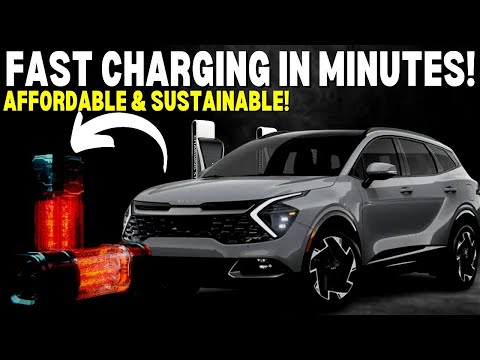This NEW Battery Breakthrough Is Set To DISRUPT The Entire Electric Industry
Electric cars are becoming increasingly popular. However, some people still don't know they want to make the purchase. And one major factor is the time needed to charge an electric vehicle.
Nowadays, most drivers expect to fill up their tanks in under five minutes. But even at the fastest charging stations, electric vehicles still take at least 30 minutes to get to 80 percent charged.
And the good news is scientists have discovered a new battery breakthrough that charges EVs in minutes!
If You Like This Video; Like, Share, Comment And Subscribe. This Means So Much To Us!
Thank You For Watching This Video; This NEW Battery Breakthrough Is Set To DISRUPT The Entire Electric Industry
Penn State researchers claim to have developed a method for creating smaller batteries for electric vehicles. And because of this, we may save a lot of money on resources that are rapidly appreciating in value.
Additionally, this facilitates quicker charging, addressing the widespread worry that electric vehicle charging will take too long.
Now, specific energies of 250–300 watt–hour–kilogram have been achieved in nickel–rich, layered oxide cathode and graphite–anode lithium-ion batteries. In addition, constructing a 90 kWh electric car pack with a 300-mile cruising range is now possible.
Unfortunately, reducing concerns about the range by employing huge batteries is not a viable solution for the widespread use of EVs. This is due to the limited supply of raw materials and the high costs.
However, quick charging in under 10 minutes makes it possible to reduce the size of EV batteries, improving both cost and sustainability.
But still, it is difficult to rapidly charge batteries with a high energy density of more than 250 Wh kg.
And that's when researchers used a dual salt electrolyte that is thermally stable using an asymmetric temperature modulation strategy. These measures are taken so that a 265 Wh kg battery may be charged to 75 percent capacity in 12 minutes for more than 900 or 2,000 cycles.
It's the same as having a range of 500 thousand miles if you charge at the maximum possible speed after every use.
Additionally, they constructed a digital duplicate of the battery pack to evaluate its cooling and safety. It was also made to show that air convection is all that is needed for thermally regulated 4C charging.
This provides a low-overhead and inherently secure path from cell-to-pack development.
Now, next-generation materials, such as anodes made of silicon or lithium metal, have the potential to be both stable and fast-charging. And this is because of a technique that uses rapid temperature modulation to create highly active electrochemical surfaces only during fast charging.
Alright, that is one really complex explanation.
But, let's break it down using a news release from Penn State as our guide.
So, research leader Chao-Yang Wang said there is an increasing need for lightweight, quick-charging batteries. And there are not enough batteries or other crucial raw materials, especially locally manufactured ones, to fulfill projected demand.
California, the largest vehicle market in the United States, plans to phase out the internal combustion engine completely by 2035.
However, battery-electric cars have two significant challenges that must be addressed before they can capture a larger share of the new car market.
First, they have a terrible recharge time. And second, their size prevents them from being practical and inexpensive.
However, according to Wang, their rapid charging method is compatible with most high-capacity batteries. It will also present a new opportunity to reduce the battery capacity of electric vehicles from 150 kWh to 50 kWh without worrying about the effect on drivers' safety.
He also mentioned that the battery cost will be much reduced due to the smaller, faster-charging batteries. It will also reduce demand for rare metals like cobalt, graphite, and lithium, paving the way for widespread sales of inexpensive electric vehicles.
Now, the technology utilizes an active approach to temperature management known as internal thermal modulation to get the most out of the battery.
Basically, if you keep your battery warm but not too warm, it will perform optimally.
Now, it has been a significant issue for battery technologists to maintain batteries at the optimal temperature.
And traditionally, the temperature of batteries has been maintained by large, cumbersome external heating and cooling systems. However, response takes a while and consumes a lot of power.
As a result, the team chose to implement temperature controls within the battery itself.
Nowadays, most drivers expect to fill up their tanks in under five minutes. But even at the fastest charging stations, electric vehicles still take at least 30 minutes to get to 80 percent charged.
And the good news is scientists have discovered a new battery breakthrough that charges EVs in minutes!
If You Like This Video; Like, Share, Comment And Subscribe. This Means So Much To Us!
Thank You For Watching This Video; This NEW Battery Breakthrough Is Set To DISRUPT The Entire Electric Industry
Penn State researchers claim to have developed a method for creating smaller batteries for electric vehicles. And because of this, we may save a lot of money on resources that are rapidly appreciating in value.
Additionally, this facilitates quicker charging, addressing the widespread worry that electric vehicle charging will take too long.
Now, specific energies of 250–300 watt–hour–kilogram have been achieved in nickel–rich, layered oxide cathode and graphite–anode lithium-ion batteries. In addition, constructing a 90 kWh electric car pack with a 300-mile cruising range is now possible.
Unfortunately, reducing concerns about the range by employing huge batteries is not a viable solution for the widespread use of EVs. This is due to the limited supply of raw materials and the high costs.
However, quick charging in under 10 minutes makes it possible to reduce the size of EV batteries, improving both cost and sustainability.
But still, it is difficult to rapidly charge batteries with a high energy density of more than 250 Wh kg.
And that's when researchers used a dual salt electrolyte that is thermally stable using an asymmetric temperature modulation strategy. These measures are taken so that a 265 Wh kg battery may be charged to 75 percent capacity in 12 minutes for more than 900 or 2,000 cycles.
It's the same as having a range of 500 thousand miles if you charge at the maximum possible speed after every use.
Additionally, they constructed a digital duplicate of the battery pack to evaluate its cooling and safety. It was also made to show that air convection is all that is needed for thermally regulated 4C charging.
This provides a low-overhead and inherently secure path from cell-to-pack development.
Now, next-generation materials, such as anodes made of silicon or lithium metal, have the potential to be both stable and fast-charging. And this is because of a technique that uses rapid temperature modulation to create highly active electrochemical surfaces only during fast charging.
Alright, that is one really complex explanation.
But, let's break it down using a news release from Penn State as our guide.
So, research leader Chao-Yang Wang said there is an increasing need for lightweight, quick-charging batteries. And there are not enough batteries or other crucial raw materials, especially locally manufactured ones, to fulfill projected demand.
California, the largest vehicle market in the United States, plans to phase out the internal combustion engine completely by 2035.
However, battery-electric cars have two significant challenges that must be addressed before they can capture a larger share of the new car market.
First, they have a terrible recharge time. And second, their size prevents them from being practical and inexpensive.
However, according to Wang, their rapid charging method is compatible with most high-capacity batteries. It will also present a new opportunity to reduce the battery capacity of electric vehicles from 150 kWh to 50 kWh without worrying about the effect on drivers' safety.
He also mentioned that the battery cost will be much reduced due to the smaller, faster-charging batteries. It will also reduce demand for rare metals like cobalt, graphite, and lithium, paving the way for widespread sales of inexpensive electric vehicles.
Now, the technology utilizes an active approach to temperature management known as internal thermal modulation to get the most out of the battery.
Basically, if you keep your battery warm but not too warm, it will perform optimally.
Now, it has been a significant issue for battery technologists to maintain batteries at the optimal temperature.
And traditionally, the temperature of batteries has been maintained by large, cumbersome external heating and cooling systems. However, response takes a while and consumes a lot of power.
As a result, the team chose to implement temperature controls within the battery itself.
People In This Video
No users are tagged in this video
Tags
No tags available yet








